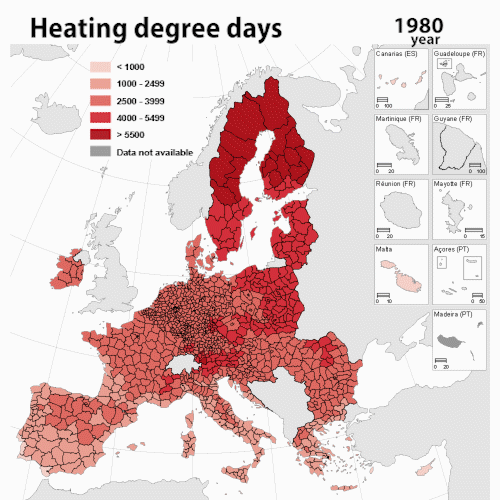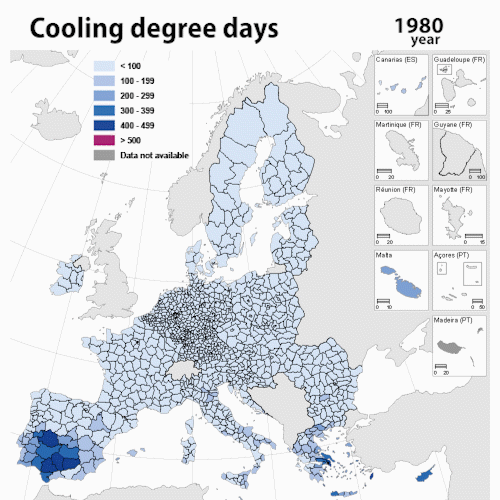The need to heat buildings has decreased over time: the heating degree days value decreased by 21% between 1979 (3 510 days) and 2020 (2 759 days) in the EU-27, indicating that, compared with 1979 only 79% of the heating needs were required in 2020.
Heating degree days and cooling degree days are weather-based technical indexes designed to describe the energy requirements of buildings in terms of heating or cooling.
Source dataset: nrg_chddr2_a
In contrast, the cooling degree days value was more than twice as high in 2020 (99 days) as in 1979 (37 days), indicating that the needs for cooling (air conditioning) in buildings increased over the last decades.
Source dataset: nrg_chddr2_a
Highest heating degree day values in Sweden and Finland, highest cooling degree days in Cyprus and Malta
Heating degree days vary across European Member States. Considering all data available over the 1979-2020 period, Finland had the highest average annual heating degree day value (5 665), while for Malta, the value was 536.
This means that for a given building, the need for heating was ten times higher in Finland than in Malta between 1979 and 2020. Finland was followed by Sweden (5 328) and Estonia (4 344).
The Member States with the lowest values were Malta (536), followed by Cyprus (784) and Portugal (1 243).
Over the same period, Cyprus had the highest average cooling degree days value (573), followed by Malta (569) and Greece (268). The Member States with the lowest values for this index were Ireland (0.02), Sweden (0.36) and Denmark (0.91).
This means that for a given building, the need for cooling (or air conditioning) in Ireland, Sweden and Denmark were negligible between 1979 and 2020.
Several “distant” EU regions and Member States have similar average values
It is interesting to observe that some geographically distant regions/Member States have similar heating degree days average values. For example, Makroregion Poludniowo-Zachodni in Poland (3349), Slovakia (3360) and Bayern in Germany (3367) have comparable values.
Ireland (2844) has a similar average value as Grand Est in France (2819) and Alföld és Észak in Hungary (2848). Cooling degree days values for Makroregion Województwo Mazowieckie in Poland (15.7), the Czech Republic (15.8) and Zuid-Nederland in the Netherlands (16.0) are similar.
The same applies to the regions Noroeste in Spain (16.2), Hessen in Germany (16.5) and Région de Bruxelles-Capitale/Brussels Hoofdstedelijk Gewest in Belgium (16.9).
For more information:
- Statistics Explained article on Heating and cooling degree days
To contact us, please visit our User Support page.
For press queries, please contact our Media Support.



